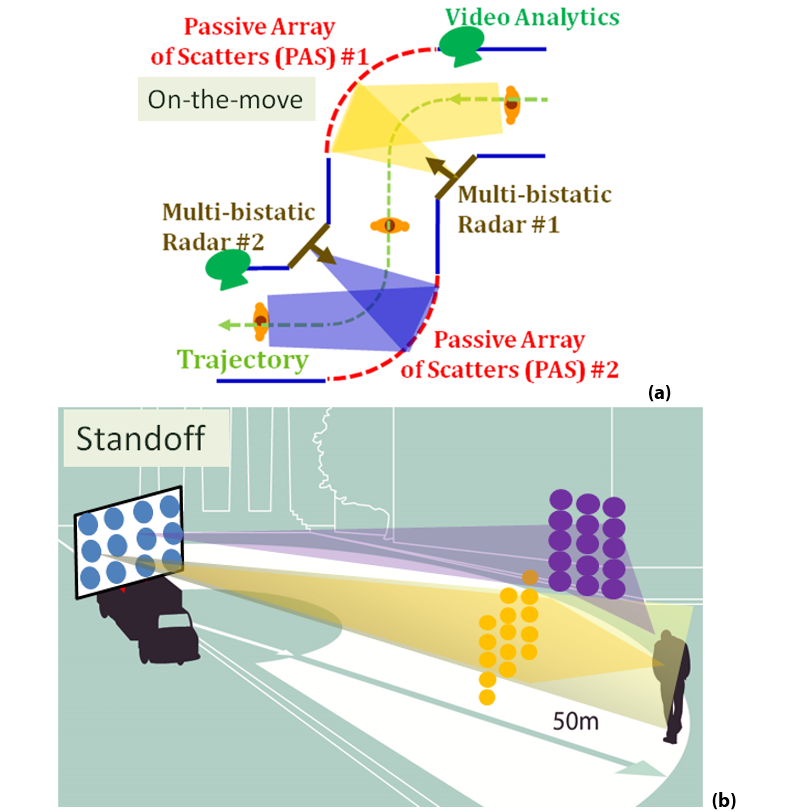News & Events
Transitioning Technology
ALERT Transitions to a DHS S&T Emeritus Center of Excellence December 16, 2021
For users without YouTube access: The ALERT Center Overview
As of spring 2021, ALERT transitioned to become an emeritus Department of Homeland Security (DHS) Science and Technology (S&T) Directorate Center of Excellence.
Since its founding in 2008, ALERT has conducted transformational research, developed technologies, and provided educational development to improve the effective characterization, detection, mitigation and response to explosives-related threats facing the country and the world. Throughout ALERT’s existence, we have worked with strategic partners Northeastern University, Boston University, Purdue University and the University of Rhode Island towards our goals of eliminating illicit explosives, improving on actionable tracing detection, raising the reliability of screening, increasing the accuracy of long distance stand-off discovery of threats and seamlessly transitioning research.
As an Emeritus Center of Excellence, ALERT will continue to conduct research and technology development on several Task Orders and will continue to organize the Advanced Development for Security Applications (ADSA) and the Customs and Border Protection – Advanced Developments Encompassing Processes and Technologies (CBP-ADEPT) workshop series.
In our latest video, ALERT Director Michael Silevitch discusses ALERT’s impact over the years, including but not limited to, the test beds and task orders that have been ushering ALERT technology into the field and into industrial partnerships.
ADSA19 Workshop Brings Academia, Industry, and Government Together November 29, 2018

The Nineteenth Advanced Development for Security Applications (ADSA19) Workshop occurred on October 16-17, 2018 at Northeastern University in Boston, MA. Close to 150 participants from academia, industry, and government gathered to engage in dialogue related to the theme of the workshop: “Rapid Response to an Adapting Adversary.”
Over the course of two days, subject matter experts and leaders from the Homeland Security Enterprise delivered presentations and participated in panel discussions on the topic of collecting and using metadata. Specific topics discussed included:
- Characterization of emerging threats
- Development and deployment of automated threat recognition (ATR) algorithms
- Metrics for assessing adaptability
- Operator involvement
- Third-parties, open-architectures
- Fused algorithms and systems
- Deterrence and dynamics systems
- Machine learning, simulants and simulated datasets
- Networking and cybersecurity
- Displacement
- Detecting the terrorist versus the threat
- Risk based screening using video tracking of passengers and divested objects
- Biometrics
- Air cargo
- Automation of concept of operations (automated screening lanes)
- Checkpoint CT and prohibited items
The next ADSA Workshop (ADSA20) will be held at the same location on May 15-16, 2019. The theme of the workshop will be “Design, Development, Testing, Deployment and Operation of Effective Systems.” ADSA20 is expected to continue to draw interested and engaged communities from the Homeland Security Enterprise.
The ADSA Workshop series has been convened by the DHS Center of Excellence (COE) for Awareness and Localization of Explosives-Related Threats (ALERT) since 2009. Originally named the “Algorithm Development for Security Applications” Workshop series, the name was changed following ADSA10 in 2014 to reflect how the scope of the workshop series has expanded well beyond algorithms. The ADSA Workshop series is intended to address research opportunities that may enable the development of next-generation systems and to facilitate collaboration and innovation between researchers from academia, national labs, and industry.
Presentations from the ADSA19 Workshop are available for viewing online: https://alert.northeastern.edu/transitioning-technology/adsa/final-reports-and-presentations/adsa19-presentations/
Final reports for previous ADSA Workshops are also available online: https://alert.northeastern.edu/transitioning-technology/adsa/final-reports-and-presentations/
2018 DHS COE Summit Facilitates Collaboration and Advances DHS Mission July 31, 2018

ALERT, along with other current and emeritus DHS Centers of Excellence (COEs), hosted the 2018 Centers of Excellence Summit in Arlington, Virginia on May 30-31, 2018. The event focused on the topic of “University Research and Development to Protect the Homeland.” The DHS COE Summit provided the Centers of Excellence an opportunity to showcase their innovative solutions to homeland security challenges and facilitate collaboration across homeland security enterprise leadership and component end-users and industry participants. According to ALERT Center Director, Michael B. Silevitch,
“One of the most valuable aspects of the Summit was the teamwork needed to pull it together. It required a concerted effort by all of the COEs to organize and orchestrate the event. Going forward, this teamwork will lead to meaningful cross-center collaboration.”
The agenda for the two-day long summit was launched with a keynote address from Christopher C. Krebs, Senior Official Performing the Duties of Under Secretary, National Protection and Programs Directorate (NPPD) and included talks by various security administrators, panel discussions, student posters, and a technology showcase.
Director Silevitch moderated a panel focused on “Transportation and Critical Infrastructure” on the first day of the summit. Panelists Carl Crawford, Eva Lee, David Nicol, and Detlof VonWinterfeldt addressed four questions related to this topic:
- What are some of the grand challenges that need to be addressed to enable the next generation of Homeland Security transportation and critical infrastructure solutions?
- What research needs to be done in order to address these challenges?
- How can the research outcomes be effectively transitioned to the field?
- What metrics can be used to enable a cost-benefit analysis of the research/transition impact?
ALERT’s Transition Team made connections with end users at the technology showcase and featured some of ALERT’s latest solutions in multi-view air cargo CT scanners, effective personnel screening, video tracking at the airport security checkpoint, and K9 explosives training aids.
COEs excel in advancing the state of the art thanks in large part to their student researchers. To acknowledge this, the summit provided students with the opportunity to present their work to attendees. Katherine Graham, one of ALERT’s talented undergraduate researchers, took home the Best Poster Award for her work on “Compressive Reflector Antennas for High-Sensing Capacity Imaging Applications.” These antenna designs provide a less complex and lower cost solution for high-sensing capacity millimeter wave imaging systems. Millimeter wave imaging systems have the potential for use in several near-field imaging applications such as security screening, non-destructive testing, autonomous driving, and biotechnology. The abstracts for the COE Summit student posters are available for download on the COE Summit 2018 website.
The summit provided an all-hands-on-deck approach to addressing homeland security challenges by bringing together some of the nation’s best academic, public, and private sector leaders to discuss strategies for advancing the mission of the Department of Homeland Security. ALERT looks forward to the next DHS COE Summit, and hopes you will join us there!
Time is running out! May 17, 2018

COE Summit Registration Deadline is THIS FRIDAY, May 18th
U.S. Department of Homeland Security Centers of Excellence Summit 2018: University Research & Development to Protect the Homeland
Summit Dates: May 30-31, 2018
Location: George Mason University, 3351 Fairfax Drive, Arlington, VA
The deadline to register for the 2018 Centers of Excellence (COE) Summit is this Friday, May 18th. Don’t miss this interactive event which brings together researchers, DHS components, industry and first responders to discuss next-generation technology and tools developed to solve homeland security challenges.
This year’s summit features keynotes and discussions with top leaders in homeland security, including:
- Christopher Krebs, Senior Official Performing the Duties of Under Secretary,NPPD
- Corey Gruber, Deputy Associate Administrator, Office of Response and Recovery, FEMA
- Darby LaJoye, Assistant Administrator, Office of Security Operations, TSA
- Kevin McAleenan, Commissioner, CBP
- Matthew Allen, Assistant Director, Investigative Programs Homeland Security Investigations, ICE
- William (Bill) Bryan, Senior Official Performing the Duties of the Under Secretary for Science and Technology, DHS S&T
- Anneli Bergholm Soder, Head of the Operations, Department of the Swedish Civil Contingencies Agency
- Daniel Kaniewski, Deputy Administrator for Protection and National Preparedness, Federal Emergency Management Agency
The COE Summit’s Full Agenda also includes panel sessions on homeland security topics, an innovation showcase and student posters session.
Register HERE by May 18, 2018.
The COE Summit is sponsored by the United States Department of Homeland Security Centers of Excellence (COEs). The COE network is a consortium of hundreds of universities that conduct research and education to address homeland security challenges. ALERT is one of nine current Centers of Excellence sponsored by the Department of Homeland Security Office of University Programs.
ALERT invites you to the COE Summit on May 30-31, 2018! April 20, 2018

The Department of Homeland Security Centers of Excellence Summit 2018 will take place on May 30-31, 2018 at George Mason University in Arlington Virginia. ALERT would like to invite industry partners, researchers, homeland security operators, and other center community members to gather to collaborate on this year’s theme:
University Research & Development to Protect the Homeland
The summit will feature experts on relevant subject matter to discuss homeland security challenges, and facilitate collaboration between COE researchers and DHS leadership, as well as component end-users and industry participants. This year’s summit strives to showcase innovative research and development tools and other solutions to homeland security challenges, and to provide avenues to accelerate transition from research and development to operational use for those who protect the homeland.
The program includes panels with experts, a student poster and innovation showcase, demonstrations of tools and technology, opportunities for collaboration, and an address by William N. Bryan, Senior Official Performing the Duties of the Under Secretary for Science and Technology in the Department of Homeland Security.
To register and for more information on the Centers of Excellence Summit 2018, visit the summit’s website – www.cina.gmu.edu/coe-summit-2018
The COE Summit is sponsored by the United States Department of Homeland Security Centers of Excellence (COEs). The COE network is a consortium of hundreds of universities that conduct research and education to address homeland security challenges. ALERT is one of nine current Centers of Excellence sponsored by the Department of Homeland Security Office of University Programs.
Read MoreADSA17 Presentations Now Available November 10, 2017

We are pleased to announce that the presentations from The Seventeenth Advanced Development for Security Applications Workshop (ADSA17) which was held on October 17-18, 2017 at Northeastern University in Boston, MA are now available for download. The presentations from the ADSA17 Workshop are now available at the following link: https://alert.northeastern.edu/transitioning-technology/adsa/final-reports-and-presentations/adsa17-presentations/
The title of the workshop was, “Systems Engineering of Aviation Security Systems.” View all slides, as well as the reports from past ADSA workshops here.
If you have any questions regarding the topics and technologies discussed at the workshop, please contact ALERT at [email protected].
New Video Analytics Dataset available for use August 25, 2017

ALERT Airport Re-Identification Dataset
As part of the ALERT video analytics effort, researchers at Northeastern University and Rensselaer Polytechnic Institute developed an annotated dataset that accurately reflects the real-world person re-identification problem. The dataset was constructed using video data from the six cameras installed post central security checkpoint at an active commercial airport within the United States. (No NDA required)
Read MorePatents Awarded to ALERT PI July 29, 2017

Dr. Rinaldi Awarded Two Patents for Resonators
Dr. Matteo Rinaldi, Associate Professor of Electrical and Computer Engineering at Northeastern University and principal investigator for Project R2-B.3, has been awarded two patents for his work on nano- and microelectromechanical resonators. Dr. Rinaldi’s research proposes to develop innovative Nano-Electro-Opto-Mechanical (NEOM) sensing technology platforms for the chemical analysis of trace explosives residues. This work contributed to the creation of the novel resonators patented earlier this month. Congratulations to Dr. Rinaldi and his research team for this exciting achievement!
Read MoreALERT Launches Video Analytics Lab at Kostas Research Institute May 30, 2017

A Better Testing Facility for Solving Real World Problems
Northeastern University’s George J. Kostas Research Institute for Homeland Security is now home to ALERT’s new Video Analytics Laboratory. Providing secure access, 1225 sq. feet of open space, controlled lighting conditions, and a fully networked and flexible camera grid, ALERT can better investigate and develop video and sensor technologies to address the needs of the Homeland Security Enterprise.
Using Video Technologies to Improve Passenger Experience
The first research project to leverage the lab is entitled Research and Development of Systems for Tracking Passengers and Divested Items at the Checkpoint. Supported by the DHS Science and Technology Directorate through the DHS Office of University Programs, this project is known by the acronym CLASP (Correlating Luggage and Specific Passengers) and leverages the technical expertise of ALERT research teams from Boston University, Marquette University, Northeastern University, Purdue University, and Rensselaer Polytechnic Institute. These teams will work towards developing an automated system capable of tracking passengers and divested items at airport security checkpoints.
CLASP will primarily focus on using video technologies to assist the Transportation Security Administration (TSA) in effectively identifying security incidents like theft of items, or bags left behind at the checkpoint. By automating and improving the technologies associated with these objectives, ALERT hopes to improve rates of detection and at the same time improve the passenger experience.
CLASP was the result of DHS’s interest in initial work done by ALERT Project Investigator Richard Radke’s lab. A video of their work can be seen below:
(Z. Wu and R.J. Radke, Real-Time Airport Security Checkpoint Surveillance Using a Camera Network. Workshop on Camera Networks and Wide Area Scene Analysis, in conjunction with CVPR 2011, June 2011.).
Government & Industry Partners Make the Difference
In order to deliver the system outlined in CLASP, the researchers working on the project require access to video data displaying real-world checkpoint security situations. Actual airport security video is generally restricted, so ALERT partnered with Massport, the Transportation Security Administration at Boston Logan International Airport, and industrial partners such as Rapiscan Systems to create an accurate representation of an airport security checkpoint in the ALERT Video Analytics Laboratory. This full-scale, mock airport security checkpoint uses the same hardware and design specifications currently used by the TSA at airports such as Logan, and gives ALERT a space to generate usable video data for this project and hopefully to the video analytics research community as a whole.
CLASP is just the beginning of work that can be done in this new laboratory and ALERT is hoping to leverage it for additional homeland security-related projects going forward. If you are interested in partnering with ALERT on future projects, please connect with us via email at [email protected].
Developing a Next Generation Screening System to Keep First Responders Safe, and People in Motion November 1, 2016

ALERT is working on developing the first inexpensive, high resolution millimeter-wave radar (mm-wave) system for the purpose of detecting and identifying potential suicide bombers in motion and at a safe distance. Current millimeter-wave imaging systems for security screening require people to stop and stand in front of the scanning system. The International Air Transport Association (IATA) has identified that being able to detect security threats without interrupting the motion of the person under test will be one of the most valuable features of the next generation personnel screening systems [Checkpoint of the Future Roadmap 2020, now Smart Security].
Professors Carey Rappaport and Jose Martinez are leading a team that wants to make that feature a reality. ALERT’s mm-wave radar system uses multiple radar sensors simultaneously. By coordinating transmitters and receivers from both sides of a walkway, the full picture of a subject moving between them is formed. At present, mm-wave radar is the only modality that can both penetrate and sense beneath clothing as far as 50 meters away.

General sketch of the inexpensive, high-resolution radar system used for detecting security threats (a) at mid-ranges using an “on-the-move” configuration, and (b) at standoff-ranges using a “van-based” configuration.
The high resolution mm-wave radar system has two configurations. The first configuration, “on-the-move,” will be able to distinguish security threats hidden on individuals at mid-ranges (2-10 meters) even when those individuals are in motion. The second “van-based” configuration of the system would be able to make detections at stand-off ranges (10-40 meters). The system is non-invasive, provides minimally-disruptive scanning with quality imaging and a fast data collection time of less than 10ms. ALERT’s system would also be the first radar system that is capable of functioning at multiple ranges for both indoor and outdoor scenarios
One of ALERT’s Industrial Members, HXI Inc., has been collaborating with our research team on this technology. Together, HXI and ALERT have designed, fabricated, integrated, and validated the radar system. ALERT expects that after the assembling the first Gen-3 prototype, the partnership will transition the technology to the millimeter-wave imaging market. Additionally, new low-cost miniaturized modules are being developed by HXI for the next generation mm-wave system.
To learn more about ALERT and the Development of “Stand-off” & “On-the-Move” Detection of Security Threats, contact ALERT at [email protected] or read more on the project’s page.
Caption: (Image Above Right) Gen-2 mm-wave radar system. The transmitting vertical array is shown on the left of the image, while the receiving horizontal array is shown on the right.
